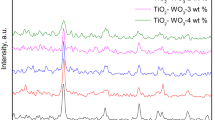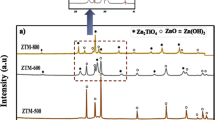Abstract
Photocatalytic degradation of pharmaceutical residues through natural solar radiation represents a green and economical treatment process. In this work, ultrasonically assisted hydrothermal synthesis of WO3-TiO2 nanocomposite was carried out at 140–150 °C for 5 h and calcinated at 600 °C. The structural and optical properties of the synthesized material were investigated using techniques like XRD, FESEM/EDX, HRTEM, BET surface area, UV-DRS optical analysis, and photocurrent response. The band gap of TiO2 was successfully reduced from 3.0 to 2.54 eV and thus making it effective under solar light. Complete degradation of paracetamol (50 ppm and natural pH of 6.5) was achieved in 3.5 h under natural sunlight at catalyst dose of 0.5 g/l. The extent of mineralization was evaluated by measuring the COD reduction. Based on the degradation products identified by GC–MS/LC-TOF–MS, the degradation process under natural solar-light could be interpreted to initiate through OH. radical species. The toxicity removal of the treated paracetamol solution under natural solar-light was evaluated by the seed germination test using Spinacia oleracea seeds and exhibited 66.70% seed germination, confirming the reduction in toxicity. The enhanced photocatalytic efficiency of the nanocomposite is attributed to the higher surface area, low rutile content, lower band gap, and incorporation of WO3, which led to an extended absorption range and a slower rate of electron–hole recombination. The technical insights presented in this research offer a feasible approach for utilizing natural solar light driven photocatalysis for wastewater treatment in an efficient and sustainable way. The proposed degradation pathway, and seed germination test (toxicity removal) of the treated paracetamol solution under natural sunlight, has not been previously evaluated.
Graphical Abstract















Similar content being viewed by others
Data availability
Not applicable.
References
Abdel-Wahab AM, Al-Shirbini AS, Mohamed O, Nasr O (2017) Photocatalytic degradation of paracetamol over magnetic flower-like TiO2/Fe2O3core-shell nanostructures. J Photochem Photobiol A Chem 347:186–198. https://doi.org/10.1016/j.jphotochem.2017.07.030
Andrade LRS, Cruz IA, Fuess LT et al (2023) Application of TiO2 nanoplates anatase [001] impregnated on Luffa Cylindrica for biostimulation of biogas production from cassava wastewater. Biocatal Agric Biotechnol 48:102653. https://doi.org/10.1016/J.BCAB.2023.102653
Antunes SC, Freitas R, Figueira E et al (2013) Biochemical effects of acetaminophen in aquatic species: edible clams Venerupis decussata and Venerupis philippinarum. Environ Sci Pollut Res 20:6658–6666. https://doi.org/10.1007/s11356-013-1784-9
Awfa D, Ateia M, Fujii M et al (2018) Photodegradation of pharmaceuticals and personal care products in water treatment using carbonaceous-TiO2 composites: a critical review of recent literature. Water Res 142:26–45. https://doi.org/10.1016/j.watres.2018.05.036
Bai S, Liu H, Sun J et al (2015) Improvement of TiO2 photocatalytic properties under visible light by WO3/TiO2 and MoO3 /TiO2 composites. Appl Surf Sci 338:61–68. https://doi.org/10.1016/J.APSUSC.2015.02.103
Balakrishnan A, Chinthala M, Polagani RK, Vo DVN (2023) Removal of tetracycline from wastewater using g-C3N4 based photocatalysts: a review. Environ Res 216:114660. https://doi.org/10.1016/J.ENVRES.2022.114660
Chen R, Han J, Yan X et al (2011) Photocatalytic activities of wet oxidation synthesized ZnO and ZnO–TiO2 thick porous films. Appl Nanosci 1:37–44. https://doi.org/10.1007/S13204-011-0005-4
dos Reis GS, Guy M, Mathieu M et al (2022) A comparative study of chemical treatment by MgCl2, ZnSO4, ZnCl2, and KOH on physicochemical properties and acetaminophen adsorption performance of biobased porous materials from tree bark residues. Colloids Surfaces A Physicochem Eng Asp 642:128626. https://doi.org/10.1016/J.COLSURFA.2022.128626
Eshaghi MM, Pourmadadi M, Rahdar A, Díez-Pascual AM (2023) Improving quercetin anticancer activity through a novel polyvinylpyrrolidone/polyvinyl alcohol/TiO2 nanocomposite. J Drug Deliv Sci Technol 81:104304. https://doi.org/10.1016/J.JDDST.2023.104304
Gad SC, Pham T (2021) Hydroquinone. Encycl Toxicol Third Ed 979–981. https://doi.org/10.1016/B978-0-12-386454-3.00855-1
Gar M, Taw A, Ookawara S (2016) Enhancement of photocatalytic activity of TiO2 by immobilization on activated carbon for degradation of pharmaceuticals. J Environ Chem Eng 4:1929–1937. https://doi.org/10.1016/j.jece.2016.03.023
Gupta G, Kansal SK, Umar A, Akbar S (2023) Visible-light driven excellent photocatalytic degradation of ofloxacin antibiotic using BiFeO3 nanoparticles. Chemosphere 314:137611. https://doi.org/10.1016/J.CHEMOSPHERE.2022.137611
Jallouli N, Elghniji K, Trabelsi H, Ksibi M (2017) Photocatalytic degradation of paracetamol on TiO2 nanoparticles and TiO2/cellulosic fiber under UV and sunlight irradiation. Arab J Chem 10:S3640–S3645. https://doi.org/10.1016/j.arabjc.2014.03.014
Kanakaraju D, Motti CA, Glass BD, Oelgemöller M (2016) Solar photolysis versus TiO2-mediated solar photocatalysis: a kinetic study of the degradation of naproxen and diclofenac in various water matrices. Environ Sci Pollut Res Int 23:17437–17448. https://doi.org/10.1007/S11356-016-6906-8
Khasawneh OFS, Palaniandy P, Palaniandy P et al (2021) Removal of acetaminophen using Fe2O3-TiO2 nanocomposites by photocatalysis under simulated solar irradiation: Optimization study. J Environ Chem Eng 9:104921. https://doi.org/10.1016/j.jece.2020.104921
Klavarioti M, Mantzavinos D, Kassinos D (2009) Removal of residual pharmaceuticals from aqueous systems by advanced oxidation processes. Environ Int 35:402–417
Kusuma M, Chandrappa GT (2019) Effect of calcination temperature on characteristic properties of CaMoO4 nanoparticles. J Sci Adv Mater Devices 4:150–157. https://doi.org/10.1016/J.JSAMD.2019.02.003
Laxma Reddy PV, Kavitha B, Kumar Reddy PA, Kim KH (2017) TiO2-based photocatalytic disinfection of microbes in aqueous media: a review. Environ Res 154:296–303. https://doi.org/10.1016/j.envres.2017.01.018
Li N, Zhang Q, Han L et al (2023) Recent advances in polydopamine and its derivatives assisted electrocatalysis and photocatalysis. Int J Hydrog Energy 48:7004–7018. https://doi.org/10.1016/J.IJHYDENE.2022.06.308
Luo Y, Zheng A, Li J et al (2023) Integrated adsorption and photodegradation of tetracycline by bismuth oxycarbonate/biochar nanocomposites. Chem Eng J 457:141228. https://doi.org/10.1016/J.CEJ.2022.141228
Mahboob I, Shafique S, Shafiq I et al (2023) Mesoporous LaVO4/MCM-48 nanocomposite with visible-light-driven photocatalytic degradation of phenol in wastewater. Environ Res 218:114983. https://doi.org/10.1016/J.ENVRES.2022.114983
Malik SN, Khan SM, Ghosh PC et al (2019) Treatment of pharmaceutical industrial wastewater by nano-catalyzed ozonation in a semi-batch reactor for improved biodegradability. Sci Total Environ 678:114–122. https://doi.org/10.1016/J.SCITOTENV.2019.04.097
Masekela D, Hintsho-Mbita NC, Sam S et al (2023) Application of BaTiO3-based catalysts for piezocatalytic, photocatalytic and piezo-photocatalytic degradation of organic pollutants and bacterial disinfection in wastewater: a comprehensive review. Arab J Chem 16:104473. https://doi.org/10.1016/J.ARABJC.2022.104473
Méndez-Arriaga F, Esplugas S, Giménez J (2008) Photocatalytic degradation of non-steroidal anti-inflammatory drugs with TiO2 and simulated solar irradiation. Water Res 42:585–594. https://doi.org/10.1016/J.WATRES.2007.08.002
Mioduska J, Zielińska-Jurek A, Janczarek M, Hupka J (2016) The effect of calcination temperature on structure and photocatalytic properties of WO3/TiO2 nanocomposites. J Nanomater 2016. https://doi.org/10.1155/2016/3145912
Mojiri A, Zhou JL, Ratnaweera H, et al (2022) Pharmaceuticals and personal care products in aquatic environments and their removal by algae-based systems. Chemosphere 288. https://doi.org/10.1016/J.CHEMOSPHERE.2021.132580
Namshah KS, Mohamed RM (2018) WO3–TiO2 nanocomposites for paracetamol degradation under visible light. Appl Nanosci 8:2021–2030. https://doi.org/10.1007/s13204-018-0888-4
Nasr O, Mohamed O, Al-Shirbini AS, Abdel-Wahab AM (2019) Photocatalytic degradation of acetaminophen over Ag, Au and Pt loaded TiO2 using solar light. J Photochem Photobiol A Chem 374:185–193. https://doi.org/10.1016/j.jphotochem.2019.01.032
Norouzi F, Pourmadadi M, Yazdian F et al (2022) PVA-based nanofibers containing chitosan modified with graphene oxide and carbon quantum dot-doped TiO2 enhance wound healing in a rat model. J Funct Biomater 13:300. https://doi.org/10.3390/JFB13040300
Pourmadadi M, Rajabzadeh-Khosroshahi M, Eshaghi MM et al (2023) TiO2-based nanocomposites for cancer diagnosis and therapy: a comprehensive review. J Drug Deliv Sci Technol 82:104370. https://doi.org/10.1016/J.JDDST.2023.104370
Pourshirband N, Nezamzadeh-Ejhieh A (2021) An efficient Z-scheme CdS/g-C3N4 nano catalyst in methyl orange photodegradation: focus on the scavenging agent and mechanism. J Mol Liq 335:116543. https://doi.org/10.1016/J.MOLLIQ.2021.116543
Pourshirband N, Nezamzadeh-Ejhieh A, Nezamoddin Mirsattari S (2020) The coupled AgI/BiOI catalyst: synthesis, brief characterization, and study of the kinetic of the EBT photodegradation. Chem Phys Lett 761:138090. https://doi.org/10.1016/J.CPLETT.2020.138090
Pourshirband N, Nezamzadeh-Ejhieh A, Mirsattari SN (2021) The CdS/g-C3N4 nano-photocatalyst: brief characterization and kinetic study of photodegradation and mineralization of methyl orange. Spectrochim Acta Part A Mol Biomol Spectrosc 248:119110. https://doi.org/10.1016/J.SAA.2020.119110
Prasad MNV, Vithanage M, Kapley A (eds) (2019) Pharmaceuticals and personal care products: waste management and treatment technology: emerging contaminants and micro pollutants. Butterworth-Heinemann, Oxford. https://doi.org/10.1016/C2017-0-03544-9
Riemenschneider W, Tanifuji M (2011) Oxalic acid. Ullmann’s Encycl Ind Chem. https://doi.org/10.1002/14356007.A18_247.PUB2
Sarat Chandra T, Malik SN, Suvidha G et al (2014) Wet air oxidation pretreatment of biomethanated distillery effluent: mapping pretreatment efficiency in terms color, toxicity reduction and biogas generation. Bioresour Technol 158:135–140. https://doi.org/10.1016/J.BIORTECH.2014.01.106
Saravanan A, Kumar PS, Jeevanantham S et al (2022) Degradation of toxic agrochemicals and pharmaceutical pollutants: effective and alternative approaches toward photocatalysis. Environ Pollut 298:118844. https://doi.org/10.1016/J.ENVPOL.2022.118844
Shah AH, Rather MA (2022) Nanoremediation: role of new generation nanomaterials for the effective removal of pharmaceutical contaminants from wastewater. Nanotechnol Infect Dis 419–436. https://doi.org/10.1007/978-981-16-9190-4_19
Shah AH, Rather MA (2020) Effect of calcination temperature on the crystallite size, particle size and zeta potential of TiO2 nanoparticles synthesized via polyol-mediated method. Mater Today Proc 44:482–488. https://doi.org/10.1016/j.matpr.2020.10.199
Shah AH, Rather MA (2021a) Pharmaceutical residues: new emerging contaminants and their mitigation by nano-photocatalysis. Adv Nano Res 10:397. https://doi.org/10.12989/ANR.2021.10.4.397
Shah AH, Rather MA (2021b) Effect of thermal treatment on the phase composition and surface properties of WO3-TiO2 nanocomposites synthesized via hydro-thermal method. ChemistrySelect 6:987–994. https://doi.org/10.1002/slct.202004160
Singh J, Sharma S, Sharma S, Singh RC (2019) Effect of tungsten doping on structural and optical properties of rutile TiO2 and band gap narrowing. Optik (stuttg) 182:538–547. https://doi.org/10.1016/J.IJLEO.2019.01.070
Sun P, Liu Y, Mo F et al (2023) Efficient photocatalytic degradation of high-concentration moxifloxacin over dodecyl benzene sulfonate modified graphitic carbon nitride: enhanced photogenerated charge separation and pollutant enrichment. J Clean Prod 393:136320. https://doi.org/10.1016/J.JCLEPRO.2023.136320
Tian W, Lin J, Zhang H, et al (2022) Kinetics and mechanism of synergistic adsorption and persulfate activation by N-doped porous carbon for antibiotics removals in single and binary solutions. J Hazard Mater 423. https://doi.org/10.1016/J.JHAZMAT.2021.127083
Vogna D, Marotta R, Napolitano A, D’Ischia M (2002) Advanced oxidation chemistry of paracetamol. UV/H2O2-induced hydroxylation/degradation pathways and 15N-aided inventory of nitrogenous breakdown products. J Org Chem 67:6143–6151. https://doi.org/10.1021/JO025604V/SUPPL_FILE/JO025604V_S1.PDF
Wang Y, Fu H, Yang X et al (2020) (2020) Pt nanoparticles-modified WO3@TiO2 core–shell ternary nanocomposites as stable and efficient photocatalysts in tetracycline degradation. J Mater Sci 5529(55):14415–14430. https://doi.org/10.1007/S10853-020-05014-6
Wei Y, Huang Y, Fang Y, et al (2019) Hollow mesoporous TiO2/WO3 sphere heterojunction with high visible-light-driven photocatalytic activity. Mater Res Bull 119. https://doi.org/10.1016/J.MATERRESBULL.2019.110571
Xu B, Zhan G, Xu B et al (2018) Degradation of acetaminophen in aqueous solution by UV and UV-activated sludge processes. Water Sci Technol 78:2088–2095. https://doi.org/10.2166/wst.2018.483
Yang L, Yu LE, Ray MB (2009) Photocatalytic oxidation of paracetamol: dominant reactants, intermediates, and reaction mechanisms. Environ Sci Technol 43:460–465. https://doi.org/10.1021/ES8020099/SUPPL_FILE/ES8020099_SI_001.PDF
Zyoud AH, Zubi A, Hejjawi S et al (2020) Removal of acetaminophen from water by simulated solar light photodegradation with ZnO and TiO2 nanoparticles: Catalytic efficiency assessment for future prospects. J Environ Chem Eng 8:104038. https://doi.org/10.1016/J.JECE.2020.104038
Author information
Authors and Affiliations
Contributions
The experimentation, data analysis and interpretation, and manuscript writing were performed by Aarif Hussain Shah under the supervision of Mushtaq Ahmad Rather.
Corresponding author
Ethics declarations
Ethics approval
Not applicable.
Consent to participate
Not applicable.
Consent for publication
Not applicable.
Competing interests
The authors declare no competing interests.
Additional information
Responsible Editor: George Z. Kyzas
Publisher's note
Springer Nature remains neutral with regard to jurisdictional claims in published maps and institutional affiliations.
Highlights
• Nanocomposite synthesized by hydrothermal method using reaction parameters that yielded higher crystallinity and reduced reaction time by 80%.
• WO3 doping used to reduce band gap of TiO2 and shift its sensitivity to visible light.
• LC-TOF-MS/GC-MS analysis of the residual reaction mixture revealed the presence of aliphatic acids only.
• The mechanism of photocatalytic degradation under natural sunlight was initiated by OH attack onto the aromatic ring.
• Toxicity removal of the treated paracetamol solution was evaluated using Spinacia oleracea seeds.
Supplementary Information
Below is the link to the electronic supplementary material.
Rights and permissions
Springer Nature or its licensor (e.g. a society or other partner) holds exclusive rights to this article under a publishing agreement with the author(s) or other rightsholder(s); author self-archiving of the accepted manuscript version of this article is solely governed by the terms of such publishing agreement and applicable law.
About this article
Cite this article
Shah, A.H., Rather, M.A. Ultrasonically assisted hydrothermal synthesis of tungsten(VI) oxide-TiO2 nanocomposites for enhanced photocatalytic degradation of non-narcotic drug paracetamol under natural solar light: insights into degradation pathway, mechanism, and toxicity assessment. Environ Sci Pollut Res 30, 93916–93933 (2023). https://doi.org/10.1007/s11356-023-28928-5
Received:
Accepted:
Published:
Issue Date:
DOI: https://doi.org/10.1007/s11356-023-28928-5




